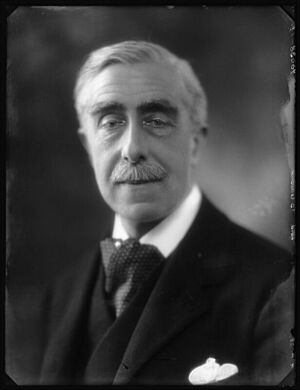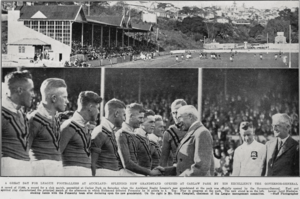Charles Bathurst, 1st Viscount Bledisloe facts for kids
Quick facts for kids
The Viscount Bledisloe
|
|
|---|---|
 |
|
| 4th Governor-General of New Zealand | |
| In office 19 March 1930 – 15 March 1935 |
|
| Monarch | George V |
| Prime Minister | Joseph Ward George Forbes |
| Preceded by | Sir Charles Fergusson |
| Succeeded by | The Viscount Galway |
| Parliamentary Secretary to the Ministry of Agriculture and Fisheries | |
| In office 11 November 1924 – 5 February 1928 |
|
| Monarch | George V |
| Prime Minister | Stanley Baldwin |
| Preceded by | Walter Smith |
| Succeeded by | The Earl of Stradbroke |
| Parliamentary Secretary to the Ministry of Food Control | |
| In office 12 December 1916 – 2 July 1917 |
|
| Monarch | George V |
| Prime Minister | David Lloyd George |
| Preceded by | Office established |
| Succeeded by | John Robert Clynes |
| Member of the House of Lords Lord Temporal |
|
| In office 15 October 1918 – 3 July 1958 Hereditary Peerage |
|
| Preceded by | Peerage created |
| Succeeded by | The 2nd Viscount Bledisloe |
| Member of Parliament for Wilton |
|
| In office 15 January 1910 – 15 October 1918 |
|
| Preceded by | Levi Lapper Morse |
| Succeeded by | Hugh Morrison |
| Personal details | |
| Born | 21 September 1867 London, England |
| Died | 3 July 1958 (aged 90) Lydney, Gloucestershire, England |
| Political party | Conservative |
| Spouses | Bertha Susan Lopes, Alina Kate Elaine Cooper-Smith |
| Children | 3 |
Charles Bathurst, who later became the 1st Viscount Bledisloe (born September 21, 1867 – died July 3, 1958), was an important British politician. He was a member of the Conservative Party. He is best known for serving as the Governor-General of New Zealand from 1930 to 1935. This was a very important job, representing the King or Queen in New Zealand.
Contents
Early Life and Education
Charles Bathurst was born in London, England. He was the second son in his family. He went to famous schools like Sherborne School and Eton College. Later, he studied law at University College, Oxford. He earned a law degree in 1890. After that, he became a barrister, which is a type of lawyer. He inherited a family estate called Lydney Park.
Becoming a Member of Parliament
Bathurst worked as a lawyer for some time. In 1910, he became a Member of Parliament (MP). He represented the Wilton area of Wiltshire for the Conservative Party. During this time, he also served as a secretary for the Ministry of Food. This meant he helped manage the country's food supply.
His Role During World War I
During the First World War (1914–1918), Bathurst joined the Royal Engineers. He worked at the War Office. He was asked to lead a group that made sure Britain had enough sugar. This was a very important task during the war. For his efforts, he was given a special honor in 1917. He was made a Baron Bledisloe in 1918. He continued to be an MP until 1928. He also worked as a secretary for the Ministry of Agriculture and Fisheries.
Governor-General of New Zealand
After leaving Parliament, Lord Bledisloe was chosen for a very special role. He became the fourth Governor-General of New Zealand. He held this position from 1930 to 1935. People in New Zealand liked and respected him very much.
Helping During the Great Depression
His time as Governor-General was during the Great Depression. This was a time when many people faced hardship. Lord Bledisloe showed great care for others. He even asked for his own salary to be cut. This showed he understood what ordinary people were going through.
Improving Relations with Māori People
Lord Bledisloe also worked to improve relations between Pākehā (New Zealanders of European descent) and Māori. He bought the land where the Treaty of Waitangi was signed. This treaty is very important in New Zealand's history. He then gave the land to the nation as a special memorial. In 1934, this site became a national reserve. Thousands of people, both Māori and Pākehā, attended the dedication ceremony. He stayed interested in the site even after he returned to England.
He also became friends with King Koroki and Te Puea Herangi. They were important Māori leaders. Lord Bledisloe was happy to use the title "king" for King Koroki. This helped to show respect for the Māori King Movement.
Promoting Sports and Other Causes
Lord Bledisloe loved to support different activities. He gave out many trophies. One of the most famous is the Bledisloe Cup. This is a trophy for a rugby union competition. It is played between New Zealand and Australia every year. He also started a chess trophy, also called the Bledisloe Cup, for chess clubs in New Zealand. He was also a freemason and led the Grand Lodge of New Zealand during his time there.
Later Life and Achievements
In 1935, Lord Bledisloe received several honors. He was given special doctorates from Oxford and Edinburgh universities. When he returned to England, he was given an even higher title. He became Viscount Bledisloe on June 24, 1935.
He continued to serve on many important committees. He was also a director for big companies like Lloyds Bank.
The Bledisloe Commission
From 1937 to 1939, Lord Bledisloe led a group called the Bledisloe Commission. This group looked at how three British territories in Central Africa could work more closely together. These territories were Southern Rhodesia, Northern Rhodesia, and Nyasaland. The idea was that working together would help them grow faster. These territories later formed the Federation of Rhodesia and Nyasaland in 1953.
Supporting Education and Agriculture
In 1943, he created the Empire Knowledge Trophies. This was a competition for schools. It aimed to teach students about the British Empire. Lord Bledisloe often presented the prizes himself. On his 90th birthday, he started the Bledisloe Gold Medal for Landowners. This award is given every year. It honors people who use science or new technology to improve farming in Britain.
Lord Bledisloe passed away at Lydney on July 3, 1958, at the age of 90. His eldest son, Benjamin Ludlow Bathurst, took over his title.
Family Life
Charles Bathurst married Hon Bertha Susan. They had two sons and one daughter.
- Benjamin Ludlow, 2nd Viscount Bledisloe (1899–1979)
- Ursula Mary (1900–1975)
- Hon. Henry Charles Hiley (1904–1969)
Bertha passed away in 1926. Bathurst then married Alina Kate Elaine Cooper-Smith in 1928. Alina died in 1956.
Sports Connections
Charles Bathurst was invited to be the President of the Lydney Rugby Football Club when it started in 1888. He held this position for 70 years until his death. His son, Benjamin, then took over. The famous Bledisloe Cup in rugby, played between Australia and New Zealand, is named after him. Also, the Bledisloe Park sports ground in New Zealand is named in his honor.



